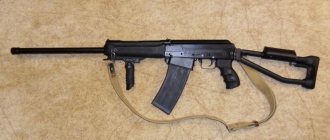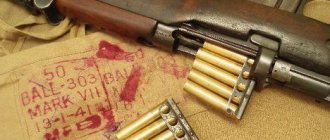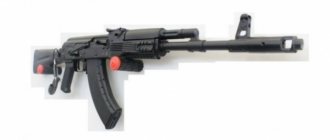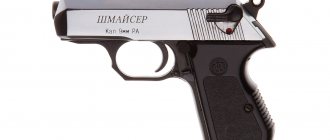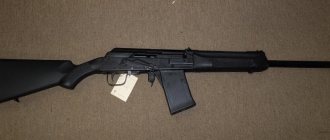The AK-12 officially entered service in 2022, and around the same time its civilian version, the TR-3 carbine, went on sale. Despite the rather high price, the carbine was an immediate hit, so it was only a matter of time before it was released in the sleek .366 caliber.
Carabiner KK TR3 366TKM 70,290 RUR
Carbine KK TR3 366TKM
Licensed product Not delivered to TC
Notify about arrival
And now, finally, that time has come - now you can get the latest weapons from the Kalashnikov Concern under a regular “green” license. Of course, with a small caveat - the transition to .366 caliber affected some design elements and ballistics of the weapon. We will talk about these changes in this article.
Weapon Features
The TR3 in .366 caliber differs slightly from the rifled versions in 7.6x39 and 5.45x39 in weight due to a thicker barrel, chamber, and magazines prepared for a non-standard caliber case. Here are its characteristics:
- Barrel length - 415 mm
- The length of the threaded part is no more than 140 mm
- Total length - 940 mm
- Weight - 3.8 kg
Let's take a closer look at each node and figure out exactly what changes await us.
Trunk
As mentioned above, the barrel of the smoothbore version had to be made thicker in order to withstand the loads when a bullet enters the rifling of the paradoxical area. In such a weapon, this place is quite weak, and with a large shot, an ordinary thin barrel can blow out. Here everything is in perfect order, with the exception of a slightly higher overall weight, as well as a slightly larger contact area of the gas tube to the barrel - some AK-12 handguards may not fit without finishing.
The barrel life is not indicated by the manufacturer, however, military barrels made using the same technology have a warranty life of about 15,000 shots. We can assume that for the TR-3 in .366 it will be in the region of 7000-10000 rounds.
The barrel is declared as suspended, but in fact it is rigidly connected to the gas block by welding. This fact somewhat reduces the advantages of a suspended barrel, but the accuracy and repeatability of the shot is still better than in carbines based on the AK-103 and earlier AKs.
DTK
The muzzle device for weapons of the AK-12/15 family is not mounted on a threaded connection, as before, but on a bayonet fastener. On the one hand, this simplifies the installation of the device and eliminates sticking of the thread, but on the other hand, the assembly becomes somewhat more vulnerable to contamination, and the range of muzzle devices is sharply narrowed due to the specificity of the connector. The concern promised to release compatible adapters in the near future, but this problem is still not resolved.
The standard DTK flash suppressor does a good job and significantly reduces barrel kick, which is especially important for the .366 caliber - its energy is higher than 7.62x39, the recoil is drier and stronger, and the kick is greater.
Gas block
The gas block is unregulated and rigidly welded to the barrel, and the gas tube, in turn, is welded to the receiver. Maintenance of the unit is carried out through a plug in the front of the tube. A rigidly fixed tube reduces parasitic vibrations during automatic operation and increases the stability and repeatability of the shot.
USM and control units
The TR-3 uses a standard long-stroke trigger from Saiga MK, which is reliable and repairable. If desired, you can replace it with a sports short-stroke version.
Despite the fact that the trigger is visually on three axes, the third axis was added for visual similarity with the army version and does not carry any real functional load.
The fire selector has 2 positions and in the civilian version traditionally serves as a fuse. The shape of the translator has been modified to make it easier to operate with your thumb. The movement of the translator causes criticism - in the “fire” position the translator hangs a little from the receiver, and theoretically can get caught on clothing.
On the side of the receiver there is also a traditional firing axis when the stock is folded.
Sights
Modern weapons are designed to solve different problems than 50-60 years ago, and the Kalashnikov Concern, knowing this, is gradually moving away from traditional open mechanical sighting devices. Instead, the TR-3 carbine provides the ability to mount any optical sights and collimators directly on the rail on the receiver. Unlike other receiver covers with a strap, the TR-3 has a special mechanism that centers the cover and eliminates its play, which solves the problem of the STP shifting after cleaning or access to the automatic weapon.
But the weapon also has open sights - this is a diopter rear sight, which allows for more accurate shooting than a traditional open rear sight at distances of up to 150 meters. You may have seen similar sighting devices on biathletes and bullet shooters, as well as on foreign army weapons.
Body kit
The aggressive silhouette of the carbine is due to the modern polymer body kit - it is quite convenient, so that most users will not have to change or add anything additional.
The handguard is small and comfortable - allows you to operate the weapon with a Magpul grip. In addition, it is suspended, which adds repeatability to the shot, especially when supported on surfaces made of different materials. For large shooters, the handguard may seem a little short, but fortunately there is already a fairly large amount of tuning for the AK-12 platform on sale, including long handguards.
The stock is folding, telescopic, and can be expanded into 4 positions. It has a sliding butt pad, so it can be adapted for shooting from non-standard positions, or, for example, in thick clothing.
In the buttstock, in a compact case, there are tools for servicing the carbine, and a folding cleaning rod - not very convenient accessories, but they are better than nothing and, if desired, you can get by with only them.
Shop
The carbine is fed from a new 10-place polymer magazine designed by V.V. Zlobina, with a beveled heel and windows.
The beveled heel adds stability when shooting with the magazine resting on it. Windows covered with a transparent plate allow you to visually monitor the remaining ammunition in the store.
Magazines for the TR-3 .366 are designed for the specifics of the cartridge, and you don’t have to add anything extra. Also, any magazines for AK in caliber 7.62x39 designed for weapons without crackers are suitable for feeding - of course, with a small addition.
Self-loading carbine Kalashnikov TR3 / Saiga AK-12 (Russia)
The Kalashnikov TR3 self-loading carbine , formerly known as the Saiga AK-12, was first shown back in 2022. Its serial production was started by the Kalashnikov concern in 2019, on the basis of the 5.45mm AK-12 assault rifle and its 7.62mm variant AK-15, which was adopted and put into production in 2018. The Kalashnikov TR3 carbine is also available in two versions, chambered for 5.45x39mm and 7.62x39mm cartridges, and is maximally unified with combat prototypes. Its main differences from the “military” versions are the inability to fire in bursts and the trigger mechanism being blocked when the stock is folded.
Self-loading Kalashnikov TR3 carbine, formerly known as Saiga AK-12, 7.62mm caliber variant (photo: Kalashnikov concern)
The Kalashnikov TR3 self-loading carbine uses classic automatics with a gas engine with a long piston stroke and locking with a rotating bolt on two lugs. The receiver is stamped from steel. The receiver cover is steel, removable, with an integrated Picatinny rail. The receiver cover is secured with a transverse pin located in the front receiver liner and cannot be completely removed from the weapon during disassembly. To eliminate the appearance of backlashes, a special spring-loaded stop is built into the rear part of the cover, interacting with the rear liner of the receiver. Similar to the AK-12 assault rifles, the forend of the Kalashnikov TR3 carbine is suspended, that is, it does not touch the barrel and does not transfer to it the loads created by the shooter’s hand or support when shooting. The gas tube is rigidly fixed in the receiver; its cleaning and maintenance are carried out from the front, when removing a special plug. The design of the plug allows for its simple replacement, including with a gas regulator, the production of which can be expected from various small manufacturers of accessories for tuning weapons. The forend and gas tube trim, made of durable plastic, have additional Picatinny rails. The trigger mechanism is trigger-type, three-axis; the safety has an additional “pedal” shelf for the index finger. The stock is from an AK-12 assault rifle, folding to the left and adjustable in length. The butt tube contains a case with accessories and a dismountable cleaning rod; an additional case for accessories is located in the hollow pistol grip. Mechanical sighting devices include a height-adjustable front sight in the front sight and a diopter rear sight, which has a range adjustment from 100 to 800 meters and a mechanism for entering lateral corrections. The barrel has a quick-release muzzle brake-compensator mounted on a special bayonet mount. TR3 carbines (Saiga AK-12) use magazines compatible with Kalashnikov assault rifles in the corresponding calibers. The carbines are standardly equipped with AK-12 or AK-15 magazines, the capacity of which is limited to 10 rounds.
| Characteristic | Meaning |
| Chuck used | 5.45×39 7N6 7N10 7N22, 7.62×39 M43 |
| Automation type | self-loading |
| USM type | sa |
| Length, mm | 880 — 940 |
| Length with stock folded, mm | 690 |
| Barrel length, mm | 415 |
| Weight without cartridges, kg | 3,8 |
| Magazine capacity, cartridges | 10, 30 |
Advantages and disadvantages
It is difficult to draw any conclusions about the carbine yet, because there is very little actual experience in using it. But we can absolutely say that the weapon turned out to be interesting, with good shooting qualities, and has no competitors in its class.
Carabiner KK TR3 366TKM 70,290 RUR
Carbine KK TR3 366TKM
Licensed product Not delivered to TC
Notify about arrival
Pros:
- Made on the basis of the latest AK-12 assault rifle, which recently entered service with the Russian Army.
- It has excellent ballistics, and due to the suspended forend and conventionally suspended barrel, it surpasses all similar AK-based carbines in .366 caliber.
- Good ergonomics, comfortable modern body kit.
- Available under green license.
Minuses:
- All the disadvantages inherent in .366 weapons apply to the TR-3 in full - the high cost of a shot, poor flatness, a strong drop in ballistic characteristics at distances above 200 meters.
- The high price of weapons, significantly higher than analogues.
Who is it suitable for?
The TR-3 carbine is suitable primarily for tactical training of civilian shooters, since it completely replicates the army AK-12, and accordingly, the operating skills of this weapon will be the same.
The carbine is also suitable for novice IPSC shooters - it is almost ready for competitions right out of the box, all you have to do is install a red dot sight and an extended magazine receiver neck on it.
To a lesser extent, the TR-3 is suitable for hunting. Despite the fact that it is nominally capable of performing all the tasks for which the .366 caliber is designed, in practice it is still a fairly heavy military weapon, albeit an accurate one. For hunting ungulates, we will recommend you a more suitable weapon in .366 caliber, for example “Ladoga” from Adar, “Ermine” from Vyatskie Polyany, or any SKS in this caliber.
Encyclopedia .366 TKM
Bullet shooting and the development of small smoothbore calibers go hand in hand and are rapidly progressing. New types of cartridges and bullets are appearing, and recently we have witnessed the emergence of new, interesting calibers. Undoubtedly, the caliber .366 TKM attracted the most attention. In 2014 (Izhevsk), at the suggestion of Vyatsko-Polyansky, it was decided to develop a cartridge of small caliber, but high power and accuracy for smooth-bore weapons. Gradually the contour of the cartridge and the required performance characteristics were determined. The conical sleeve, which distinguishes the caliber from all other smoothbore cartridges, makes it easier to feed it from the magazine into the barrel and remove the spent cartridge from the chamber, and this allows you to increase the pressure and, accordingly, the energy.
As a starting point, it was decided to take the metal sleeve of one of the most popular cartridges - 7.62x39, but without a formed barrel. There were several arguments in favor of this choice. Firstly, many Soviet and Russian models of small arms were produced for this caliber, and in addition, it ensured ease of restructuring of cartridge production. To exclude the possibility of firing using rifled cartridges in the newly created “cartridge-weapon” complex, it was decided to use fixation in the chamber at the end of the cartridge case. This also made it possible to obtain a maximum bullet diameter of the new cartridge of 9.55 mm and a weight of 11–15 g. After some time, the first prototypes of cartridges and weapons for them were created. The ammunition received the caliber name - .366 (cartridge caliber in fractions of an inch) and the abbreviation - TKM (“Tehkrim-Molot”). With this name, it was submitted and accepted into the PMK of the Brussels Commission for the Mutual Recognition of Stamps. The first weapon model for this caliber was created as part of the “cartridge-weapon” complex based on the Simonov self-loading carbine - SKS and received the VPO-208 index. On May 21, 2015, in St. Petersburg, the hunting cartridge for smoothbore weapons of .366 TKM caliber and the VPO-208 shotgun were presented to the gun community for the first time. Those who are “in the know” immediately had a question: “If a smooth-bore weapon bullet, as a rule, has a specific shape for stabilization along the trajectory, then why doesn’t a regular bullet tumble in flight in this caliber?” The answer is simple: for smooth-bore weapons, the Law “On Weapons” allows the presence of a rifled part with a length of no more than 140 mm. It is this rifled part of the barrel - the “paradox”, located in the muzzle, that gives the bullet rotation and, as a result, gyroscopic stabilization. Later, a variation of the weapon was proposed with an oval-helical barrel bore (Lancaster drill) along the entire length of the bore. The accuracy of the cartridge and weapon allows the bullet dispersion diameter at a distance of 100 m to be no more than 2 MOA (approximately 60 mm). The large diameter and mass of the bullet, the relative “blunt-headed” shape, provides a high stopping effect, which, in turn, allows you to confidently hit targets up to an adult elk with a semi-jacketed bullet. This combination of precision, power and initial availability of the complex allows us to attract an increasing number of buyers every year. Despite the market’s caution regarding new products, and even in a completely new caliber, the range of weapons produced is constantly increasing. So, at the moment, 10 types of weapons are produced in more than 15 modifications. Among them are both re-barrelled SKS and AK in various versions, as well as newly manufactured weapons. New “bolt-on” and break-through models of weapons are being prepared for release, as well as insert barrels for models of this caliber - MP-27 and MP-18. As with any smooth-bore weapon, ammunition can be equipped by the hunter himself, while he will be within the legal framework of the law “On Weapons”. CJSC Tekhkrim actively contributes to this by releasing cartridge components for sale. At the beginning of the life of the new ammunition and weapons for it, childhood illnesses appeared - not everything was perfect with both the cartridges and the weapons. The main problems of cartridge reliability were associated with the novelty of technical solutions, the quality of components, and the emergence of mass production. The coordinated work of all services to eliminate these problems has improved the quality of the cartridges, which has been noticed by the consumer.
“Dary” The first cartridges with the cast bullet “Dary” (with two grooves) were launched into mass production in 2015, but then the shape of the bullet was changed, which ensured better accuracy. The peculiarity of this bullet is that it is made of solid lead, on which a polymer coating is applied, this reduces the friction of the bullet, protects the bore from lead, reduces heating and increases the service life of the weapon. Designed for hunting animals from 10 to 100 kg at a distance of up to 150 m and target shooting.
FMJ Serial production started in May 2022. The FMJ bullet is a fully jacketed bullet consisting of two elements: a tombak jacket and a soft lead core placed inside it. Such a bullet is suitable for hunting small game species, since it practically does not deform when passing through soft tissue and does not leave large hematomas in the target. The bullet is also suitable for recreational shooting, because... has high penetration ability.
“Etna” In preparation for serial production in November 2017. The copper expansive bullet has a profiled cavity in the nose that provides programmable opening. The profile of the cavity in the nose is set based on the condition of the impact opening of the bullet at a depth of 2–2.5 bullet lengths after hitting the target. This impact provides a high stopping effect, which allows you to confidently hit even large species of game. To improve aerodynamics and accuracy, the hole in the nose is covered with a fairing.
“EKO” Certified and put into serial production in September 2022. Ammunition with a light bullet with a flat trajectory, ensures stable operation of the automatic equipment of AK-like models (VPO-209, etc.). The conical shape was chosen to improve full loading into standard AK magazines without modifying them. The bullet material is soft zinc alloy. The internal rear cone and two knurled grooves on the cylindrical part reduce barrel wear and guarantee preservation of accuracy throughout the entire service life of the weapon. Today this is the most budget cartridge in the .366 TKM caliber. The cartridge was originally planned for target shooting, but showed itself well in hunting small animals.
SP13 Certified and put into mass production in October 2016. Traditional semi-shell with lead spout. The ogival shape of the front part is more optimized for hunting than the previously developed conical semi-jacketed “Cone” bullet. The shell is brass, soft lead. In November 2022, they are preparing for serial production of its modification weighing 15 g with a more durable bimetallic shell and an expansive recess in the nose.
Shot No. 10 Serial production of a shot cartridge with a container began in August 2022. The plastic container protects the lead shot when the cartridge is fed and is destroyed when passing through the “paradox”. This ensures uniformity of shot distribution. The cartridges are designed for hunting small game birds at a distance of up to 25 m.
"Hexa" Developed and produced in 2016 in a limited batch of 500 thousand units. The first bullet with predictable expansion in the .366 TKM caliber. The shell is brass, profiled, with a thick bottom. Six longitudinal concentrators are additionally created on the wall to facilitate deployment into the target. The initial batch used a .380 MeGum case as the shell. Soft lead core. A specialized hunting bullet with a good stopping effect, excellent expansion and mass retention when hitting an animal. Production will resume in 2022 with a new shell.
"Cone" Bullet has been produced since 2015. This is the first semi-jacketed bullet in the .366 TKM caliber, so a conical shape was chosen to ensure manufacturability. But, as it turned out, this gives her an advantage in fully equipping VPO-209 magazines. Brass shell, very soft lead. Easily deformed to target.
Components As with any smooth-bore weapon, ammunition can be equipped by the hunter himself. CJSC "Tekhkrim" produces components for the .366 TKM cartridge into the retail chain: "Dary" bullets, FMJ, SP13; sleeves; capsule KV-7.62N; hunting powder "Sunar 7.62".
, as the developer of the .366 TKM caliber, is the patent holder of the utility model of the cartridge and chamber. The company not only carries out technological development of already mastered types of cartridges, but also develops new models of bullets. In 2022, it is planned to fully develop the most complete range of bullets for all types of hunting and target shooting.
Of course, it’s too early to evaluate the new .366 TKM caliber, two years of sales is too little time for a final conclusion, but the fact that a new caliber has appeared in Russia, originally developed for Russian hunting conditions, is a fact. The variety of bullets developed and mastered in such a short time is a good example of the work of Russian manufacturers.
| Technical characteristics of .366 TKM cartridges | |||||||
| Model | Dary | FMJ | Eco | SP13 | Cone | Hexa | Etna |
| Weight, g | 13,5 | 14 | 6,5 | 13 | 15 | 15,5 | 12 |
| Initial speed, m/s | 550 | 600 | 800 | 650 | 600 | 550 | 600 |
| Energy, J | 2042 | 2520 | 2080 | 2746 | 2700 | 2334 | 2160 |
| Accuracy (100 m), mm | 75 | 65 | 100 | 40 | 80 | 45 | 35 |

